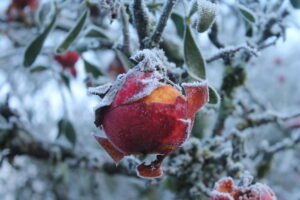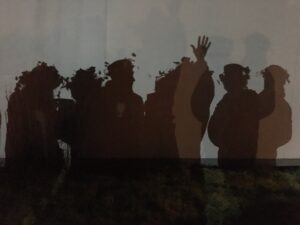As Kate Gathercole sings into the landscape, the landscape — and human history — sing back.

Today I sing as I walk. The late November afternoon sky is the luminous blue of a bright May morning, and my voice is woven with birdsong. I sing old songs, songs of the trees, songs of people who knew the trees as they moved among them. Songs that still resonate with a landscape of leaf mould and steep-sided green lanes. Songs that are filled with the changing season — the gathering in, the cold ahead of us, the dark.
Air is my medium. Air that is rippled by the flight of birds. Air that is shaped by the gentle push of me and dog passing through, here under the trees.
Philosopher and ecologist David Abram comments that ‘breathing involves a continual oscillation between exhaling and inhaling, offering ourselves to the world at one moment and drawing the world into ourselves at the next’. When I sing outdoors, air that is shaped by my mouth and lips — the story and resonance of my song — meets the breeze in the lifting of the leaves around me, duets with the complaints of a cow from a barn in the valley, chords for a moment with the sonic drone of a plane far and high overhead, returns to me…patterning me into this place in all the beautiful and awful complexity of now.
At a time when change is so rapid we find ourselves sheltering from what passes for ‘normal’, my song is my reciprocity with my local landscape. Singing old songs to the hillside — or the local park, the tree at the end of the street, the bird outside my window — feels something like tying a ribbon…growing a thread of relationship into the constancy of the other-than-human world around me, feeling their grounding.
Each winter for the past decade, together with a small group of singing friends, we have met to wassail local apple trees, and shared our singing at increasing numbers of local wassail events. We teach the folk carols we sing, and with their lyrics share both the recipes (‘sugar strands and cinnamon’) and the ritual practices that shaped this ancient annual ceremony: offering to the trees with toast and cider, and to each other a ‘wassail bowl’, affirming our care for the trees by sending off any lurking evil spirits with whoops and sticks.
When we look for the customs that describe a local indigenous ‘honouring of the harvest’ for empire building, colonialising England it is hard to find a way back past the dominance of deer parks, enclosures and land clearances. These losses seem much quieter now than those currently happening around us in the world — the start of the drive of indigenous communities from the land here in England dates back to the turn of the last millennia.
But perhaps the upsurge of interest in wassailing here now is an overdue attempt to bring us back closer to that ‘right relationship’ with the land. Somewhere deep in our collective consciousness and in our ever-growing and diversifying genetic memory is an experience of ourselves as part of the encompassing ecosystem around us — not other, not separate. The ancient rites of blessing and thanksgiving to the apple trees for their harvest — the ritual passing of a shared cup, the joining with song, the connectivity of fireside and procession — bringing us into presence here once again.
As well as the re-growth of wassail events, recent years have seen a re-growth of interest in Morris dancing. The arrival of new forms of dance, dancers, costume, and sides are exemplarised by Stroud’s all female lamé-jumpsuit wearing Boss Morris, and given further contemporary significance by Folk Dance Remixed and their combination of traditional and hip hop dance and music.
This reigniting of ancient street dance forms is a celebration of our common right to dance our connection to our surroundings and communities. The latest iterations of the Morris are vibrant and defiantly youthful, bringing new diverse groups into relationship with a custom that allegedly reaches back to medieval folk dance. When Herefordshire’s Blackthorn Ritualistic Folk put up their latest Morris event — a winter wassail in Herefordshire — tickets sold out within 5 minutes.
Alongside the growth of Morris troupes, a ‘hedge Morris’ custom that pulls inspiration from the solitary witching of Rae Beth is also evolving. Folklorist and artist Lucy Wright describes in TradFolk a sharing of personal rituals for the dawning and ‘dusking’ of earth’s calendar shifts between the summer and winter seasons. Separate in place but connected across the space of social media, solo ‘Morris’ make their way onto beaches and into woodland, performing their own dance to the trees and the hedgerows, and sharing their solitary rite with the screen watching world.

Here in Herefordshire, in the muddy fields and long valleys, we carry torches through the darkness, and stand under lone trees in torrential rain, to watch the fire and the ringing dance.
Either way, breathing into the cold air of the exchange between day and night, for a moment we are all patterned into the moving season around us…before we climb back into cars, turn on the lights and drive home.
Members of the community choir I work with have commented that singing seasonal traditional folk songs has enhanced their connection to place and landscape. “Driving or walking around with the songs in my head I felt really connected with the spring — and to others who must have felt the same way over the centuries here…” “… I felt like I wanted to put flowers in my hair and go out dancing…”
When we put an advert in our local village magazine to say that we were planning to run a seasonal community folk choir we thought we might get a handful of curious singers along. When more than 40 people arrived out of the darkness of that first February evening we realised that our invitation had met an unexpected interest in our small Herefordshire community.
Singing traditional folk songs brings a sharing of experience that is filled with the ordinariness of long time human-being. The songs reach back and forward through time — at once contemporary and historic. The songs and their evolving stories and melodies make connections that are present in the now of their universal themes — stretching out from here to the far horizon in the immediacy of their collective experience — and brought new meaning with each new singing, each new voice, each new environment.
Folk songs are resonant with a landscape of before — coded with the lives we wove, our movement through the dusk, the dawn, the forest, the factory. The songs meet us now in the fullness of love and despair and describe us again to ourselves.
‘The work is hard, the day is long – now masters all come hear our song –
Our labours are but all in vain, our wives and children we can’t maintain.
In 1852 you broke our strike, our union too, and now machines rule this fair land…’
Nailmaker’s Lament
With research it is still possible to find songs that describe the magical use of plants, right-reverence for domestic animals, the developing narrative of older woman as threat, the wisdom of the witch, affirmation of gender-queer roles, the resilience of the marginalised and lost, the merging and movement between the magical and religious. Lucy Archer writing about the song ‘Oxford City’ comments that it is ‘a traditional song over a hundred years old, but when I first read the lyrics I was reminded of things happening right now: incel culture and drink spiking’.
Easy to find are songs about grief and loss, the casual and frequent abuse of women, the powerlessness of ordinary people in the face of the state, and the relentless but joyful community of our work together, with and on the land.
And it is this feeling of community that perhaps particularly calls from folk songs. A community of voices are entangled into the history of these old songs — voices that have shaped and developed the songs, soared and whispered with them over hundreds of years.
When we bring a community together in song we grow connection with each other. When we bring that community together to sing songs that resonate with the stories of our ancestors or with ancient patterns of relationship with the land, perhaps this helps to renew our sense of belonging both with each other and with the plants and animals with whom we share our living space.
Whilst we recognise that the need to belong is basic to us as human animals, our present instinct — heightened post-pandemic — is to retreat to our homes, our small indoor private worlds and nightly Netflix. Emerging from this separation into trusting relationship is essential as we navigate the complexity of current times. Joanna Macy, Eco-Buddhist and author of Active Hope, describes in conversation with Andrew Boyd a discussion she had at one of the first Work That Reconnects workshops: ‘A seasoned activist turned to me and said ‘Why are you doing this?’…what came from my solar plexus was “So that when things fall apart, we will not turn on each other.”’
It is understood that when we sing together in community our hearts synchronise. The length of song phrases guides our respiration, resulting in compliances of frequency of heart rate variability between us. American cognitive musicologist David Huron also suggests that music stimulates the production of oxytocin, and that when music is shared in a group this strengthens the group’s bonding. There are ‘prosocial effects’, the development of trust and cooperation, amongst those who share a song.
…And here I am, out in the woods on my own with the dog, singing with the trees. ‘Hedge Singing’ perhaps. Singing old songs with a feeling of deepening connection to the land around me. Weaving the magical counter spell offered to the world by gratitude.
Nasim Haramein teaches that ‘When a complex system is far from equilibrium, small islands of coherence in a sea of chaos have the capacity to shift the entire system to a higher order’. In this complex adaptive earth space which currently feels so very far from equilibrium my small offer of coherence comes in a quiet moment of outdoor song…song that moves with the willowing of leaves in a treetop, the bowing of bough, the flight arc of a song bird. Song that sends out ripples into my surroundings and in that instance returns to me, enhanced by every other that is here. I come into the community of the world around — allowing my heart to slow and comply, my breath to feel its exchange with the air and with the voices and dance of others. The whisper of connection comes back to me, to find me.
As Robin Wall Kimmerer says, ‘The land knows you, even when you are lost.’
*
Kate Gathercole is a folk singer — part of alt-folk duo Alula Down — and a regular wassailer, permaculturist and community choir leader.